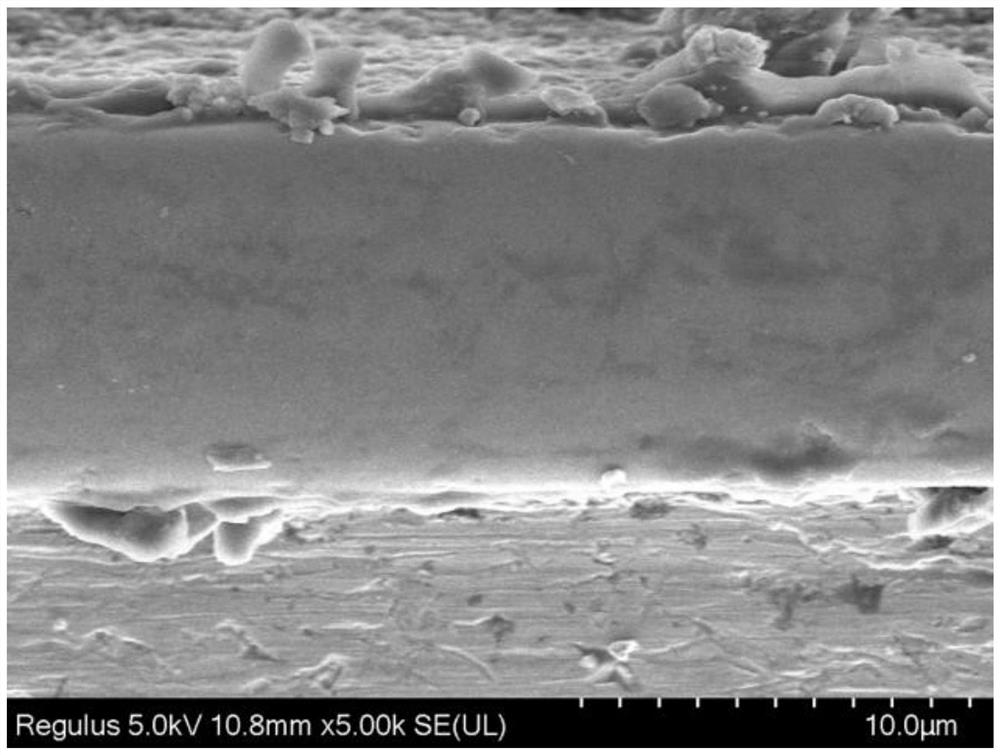A kind of preparation method of metal boride coating
A metal boride, coating technology
- Summary
- Abstract
- Description
- Claims
- Application Information
AI Technical Summary
Problems solved by technology
Method used
Image
Examples
preparation example Construction
[0026] The preparation method of the metal boride coating of the present invention comprises the following steps:
[0027] S1, preparing a solid mixed salt containing metal boride nanoparticles;
[0028] Mixing a certain proportion of solid inorganic salts, ball milling to micron level, adding metal boride nanoparticles to the ball milled mixed salt, the amount of metal boride nanoparticles added is 30% to 50% of the total weight of the mixed salt, Then add acetone liquid and ultrasonically disperse for 1-2.5 hours, vacuumize and heat in a vacuum drying oven, the heating temperature is 70°C-180°C, the vacuum degree is 30-150 Pa, and after vacuum heating treatment time is 0.5-2.5 hours, you can get Solid mixed salts containing metal boride nanoparticles.
[0029] S2, preparation of metal boride coating by electrophoretic deposition in nano-inorganic molten salt;
[0030] Put a certain proportion of solid inorganic salt into the crucible, heat to melt in an inert gas-protected...
Embodiment 1
[0038] NaF and AlF in a molar ratio of 3:2 3 Mix well, put into planetary ball mill and ball mill to micron level. In ball-milled NaF and AlF3 mixed salt, add zirconium diboride with an average particle diameter of 70 nanometers, and the weight of nano zirconium diboride is NaF and AlF 3 35% of the total weight of the mixed salt, then add acetone liquid and ultrasonically disperse for 1.5 hours, then put it into a vacuum oven for heating, the heating temperature is 150 ° C, and the vacuum degree is 100 Pa. After 1.8 hours of vacuum heat treatment, the acetone is completely volatilized to obtain di Solid-state NaF and AlF with uniform distribution of zirconium boride nanoparticles 3 Mixed salt; NaF and AlF in a molar ratio of 3:2 3 Inorganic salts were mixed and added to the graphite crucible, and under the protection of high-purity argon, they were melted in a resistance furnace at a temperature of 950°C. After complete melting, the zirconium diboride nanoparticles NaF and A...
Embodiment 2
[0040]Thoroughly mix NaCl and KCl with a molar ratio of 1:1, and put them into a planetary ball mill for ball milling to micron level. Add titanium diboride with an average particle size of 50 nanometers in the ball-milled NaCl and KCl mixed salt, the weight of nano-titanium diboride is 45% of the total weight of NaCl and KCl mixed salt, then add acetone liquid and ultrasonically disperse for 2 hours, and then placed in a vacuum oven for heating at a temperature of 130°C and a vacuum of 120 Pa. After 1.5 hours of vacuum heat treatment, the acetone was completely volatilized to obtain a solid NaCl and KCl mixed salt with titanium diboride nanoparticles evenly distributed. NaCl, KCl and AlCl with a molar ratio of 17:17:66 3 Inorganic salts were mixed and added to a quartz crucible, and under the protection of high-purity argon, they were melted in a resistance furnace at a temperature of 710°C. After complete melting, the NaCl and KCl containing titanium diboride nanoparticles p...
PUM
| Property | Measurement | Unit |
|---|---|---|
| size | aaaaa | aaaaa |
| thickness | aaaaa | aaaaa |
| thickness | aaaaa | aaaaa |
Abstract
Description
Claims
Application Information
 Login to View More
Login to View More - R&D
- Intellectual Property
- Life Sciences
- Materials
- Tech Scout
- Unparalleled Data Quality
- Higher Quality Content
- 60% Fewer Hallucinations
Browse by: Latest US Patents, China's latest patents, Technical Efficacy Thesaurus, Application Domain, Technology Topic, Popular Technical Reports.
© 2025 PatSnap. All rights reserved.Legal|Privacy policy|Modern Slavery Act Transparency Statement|Sitemap|About US| Contact US: help@patsnap.com



